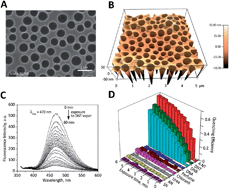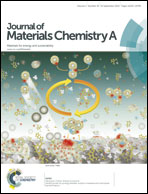A fluorescent polymer film with self-assembled three-dimensionally ordered nanopores: preparation, characterization and its application for explosives detection†
Abstract
The sensitive and rapid detection of nitroaromatic explosives typically requires sophisticated sensor materials. We demonstrate here how a simple dip-coating process of a mixture of polystyrene and the fluorophore pyrene onto a glass slide generates a self-assembled fluorescent nanostructured film expressing regular breath-figure nanopores. Morphology investigation reveals that the fluorescent polymer films consist of a high-density, three-dimensional nanoporous array of holes, allowing the fluorescence of this material to be rapidly and selectively quenched by nitroaromatic vapors. The morphology of the polymer was controlled by variation of the dip-coating parameters and the ratio of polystyrene to pyrene. This ratio also controls the fluorescence quenching efficiency of the material. We demonstrate the possible molecular origins of this through structural XRD studies as well as investigations of the electronic structure (optical properties, band gap and conduction band determinations) of the polymer film. Our results identify a novel high performance form of an otherwise known explosive-sensing material. Most importantly, the findings point toward a general method for the facile realization of well-defined three-dimensional high surface sensor materials with optimized electronic properties.


 Please wait while we load your content...
Please wait while we load your content...